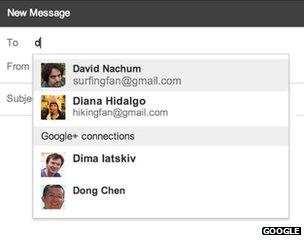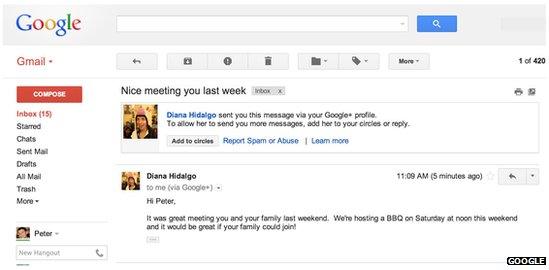New Gmail messaging feature causes privacy concerns
- Published

Gmail users will be able to message anyone with a Google+ profile, unless they opt out
Users of Google's Gmail service will soon be able to send messages directly to other Gmail accounts, regardless of whether the recipient has shared their email address.
The new feature will include everyone signed up to both Gmail and Google+, the web giant's social network.
The change has caused concern among some privacy advocates, who say people could be contacted by strangers.
Google says it will make it easier for users to communicate with friends.
But privacy campaigner Marc Rotenberg, of the Electronic Privacy Information Center, called the new feature "troubling", and compared it to a privacy flaw in a previous Google product.
"There is a strong echo of the Google Buzz snafu," he said, referring to an early incarnation of the company's social network, which initially made a list of Gmail users' contacts available publicly online.
'Easier to connect'
Gmail members will see a list of their Google+ connections when they begin to type a name in the 'To' field of their messages, even if they do not know the email address of the person they are attempting to contact.
The update was announced on Google's Gmail blog, external on Thursday by product manager David Nachum, who said the change would make it "easier for people using Gmail and Google+ to connect over email".
Users will have the option of disabling the new feature and can choose to allow only those within their 'Circles' to contact them.
However, the default setting allows anyone on the network to get in touch without prior consent.
Address hidden
Mr Nachum said that all users would be alerted to the new feature and how to change the default setting, within the next few days.

Messages from Google+ connections will go directly to Gmail users' inboxes
He also explained that email addresses will not be visible to a Google+ connection until a user replies to that person's initial message.
Google's update to Gmail messaging is the latest in a series of moves designed to bring its email service and social network Google+ closer together.
Users signing up to Gmail are now automatically given a Google+ account, unless they choose to disable it.
- Published3 January 2014
- Published24 September 2013
- Published16 August 2013